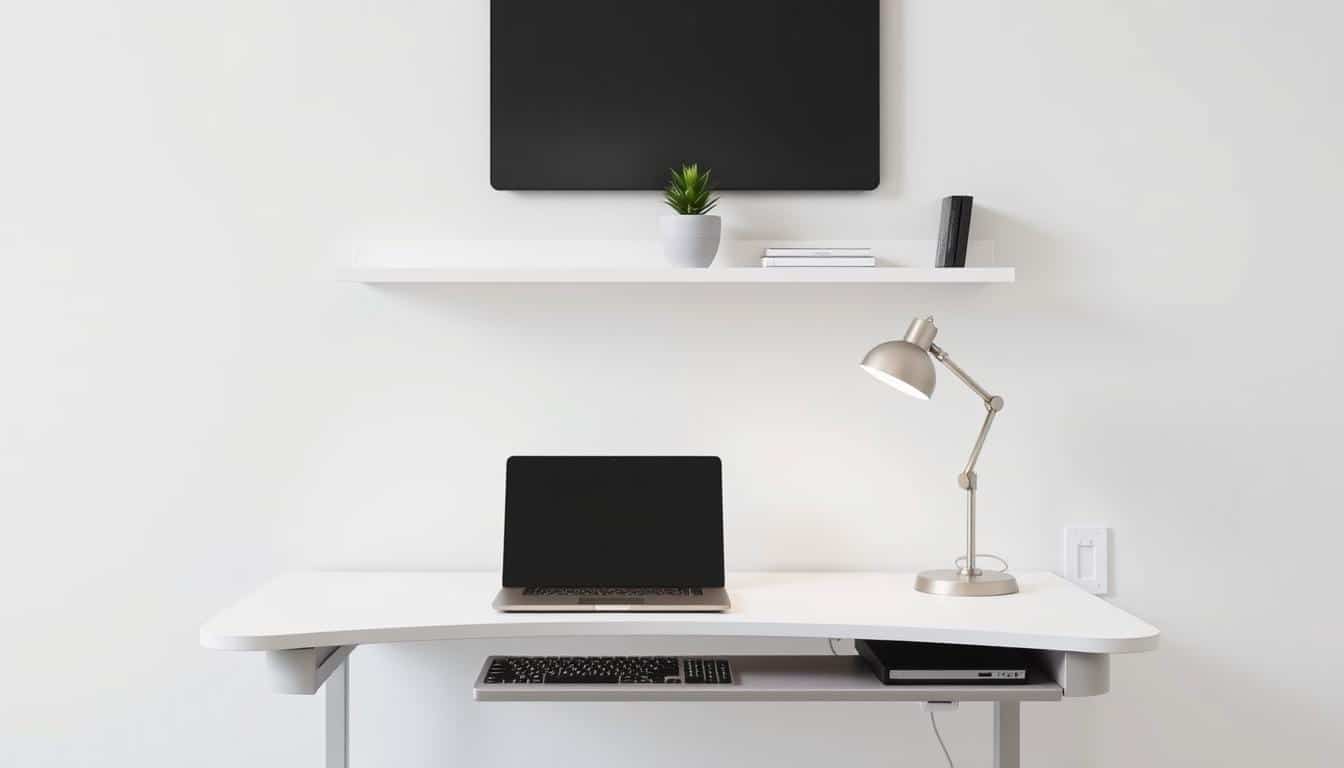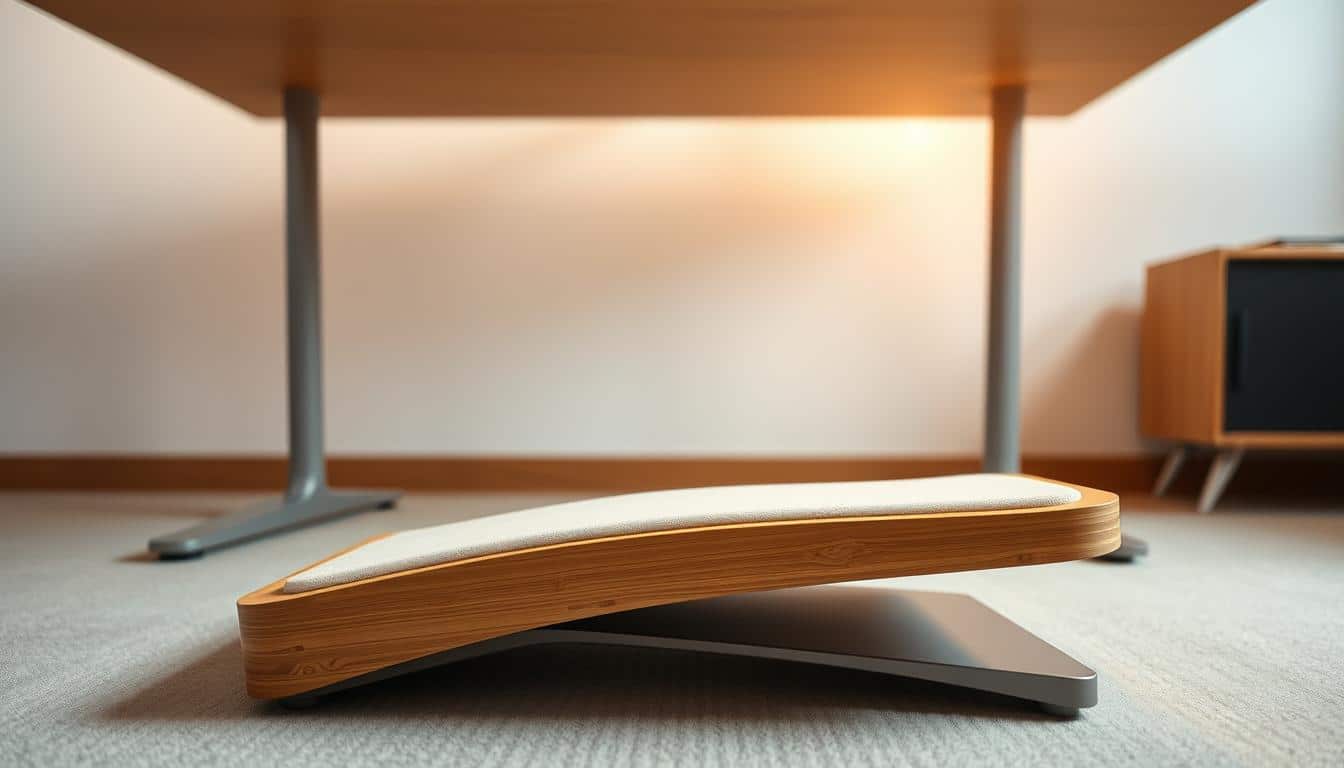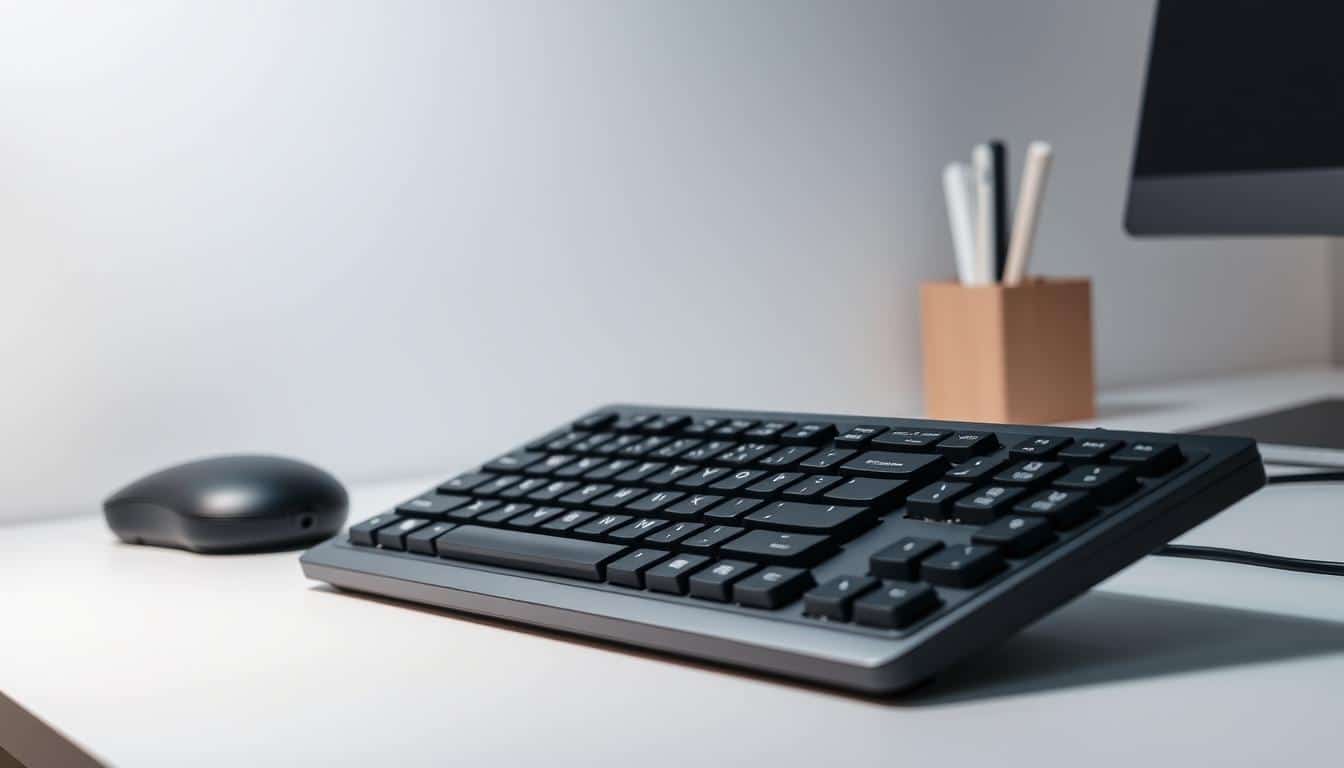The shift to remote work has made optimizing small home offices important. A smartly planned workspace, even if small, can make you work better and do more.
The way your home office is set up can really affect your work and life balance. We’ll show you how to make even tiny spaces work well for you.
Understanding the Importance of a Productive Home Office
Today’s work scene really values the perks of remote work. It’s not just about being comfy at home. It’s also about having the freedom to manage your time and energy. By setting up a work area that feels just right, you’re more likely to stay focused. And when you’re focused, you get more done.
Benefits of Working from Home
Working remotely gives you the reins of your daily schedule. This supports a solid balance between work and personal life. The top perks are:
- Being able to work whenever suits you best, making room for other parts of life.
- Saying goodbye to long commutes, freeing up more time for work or fun.
- Creating a working nook that’s all about your comfort and preferences.
Creating a Distraction-Free Environment
To really zero in on work at home, cutting out distractions is key. Setting clear real and mental boundaries boosts productivity. Here are the best ways to make your work zone distraction-free:
- Choose a specific spot for work to keep it separate from home life.
- Use soundproofing or noise-canceling headphones to block out unwanted noise.
- Have a daily routine that marks the start and finish of work hours.

Workspace Optimization for Small Home Office Spaces
Making your small office space more efficient can really help with your work and creativity. It’s important to use workspace optimization tricks to get the most out of your space. A smart layout can make a tiny room both useful and cozy.
Maximizing Every Square Foot
Planning your office’s layout is key for using a small space well. Here are some strategies:
- Furniture Placement: Putting your desk near natural light can make you feel better and help you focus.
- Defined Zones: Set up separate areas for working, chilling out, and storing things to make work easier.
- Decluttering: Regularly check what you have in the office. Keep only essentials to reduce distractions.
Effective Use of Vertical Space
Using the walls for storage can help keep your small office tidy and open. Here’s how to do vertical storage right:
- Wall-mounted Shelves: Shelves on the wall are great for keeping books and decor without losing floor space.
- Hanging Organizers: Use hanging organizers to store items without taking up space on your desk or shelves.
- Overhead Cabinets: Cabinets above your desk can hide clutter and make your office look neater.
Choosing the Right Furniture
Choosing the right furniture is key for a small home office. You should pick compact desks to use space well. Ergonomic furniture is important too. It keeps you comfortable and healthy when you work long hours. Good furniture fits your space and boosts both productivity and organization.
Compact Desks and Ergonomic Chairs
Compact desks are perfect for small spots. They’re designed to be simple, which helps avoid a messy desk. Add an ergonomic chair for support while you sit for hours. These chairs adjust to you, with back support and wheels for moving easily.
Multi-functional Furniture Options
Furniture that does more than one job is great for small offices. A desk with storage keeps things tidy. Also, try seating that can store items. It saves space and looks good. Choosing furniture like this makes your office neat and efficient.
Incorporating Smart Storage Solutions
Keeping a small office organized is key to staying productive and cutting down on clutter. Using smart storage solutions can really help make your workspace better. For example, built-in storage fits right in with your space and makes use of every inch. Also, adding shelves up high and wall organizers can help clear the floor. This makes sure your office is neat and you can find things easily.
Using Built-in Storage
Built-in storage has a sleek look and makes great use of space. This can include:
- Cubbies and cabinets built into walls
- Drawers under desks to hide stuff away
- Bookcases that match the rest of the room
These options don’t just look good—they also make it easier to grab what you need, keeping work smooth.
Vertical Shelving and Wall-Mounted Organizers
For keeping office stuff and papers in order without taking up desk space, vertical shelves and wall organizers are tops. Look at these good ideas:
- Floating shelves for showing off books and decorations
- Wall-mounted holders for easy access to papers
- Magnetic strips for sticking tools and stationery
Using these clever storage ideas helps keep things tidy. Plus, they let you get to your stuff quickly, helping you stay focused while working.
Creating a Cozy and Inviting Atmosphere
The atmosphere of your home office impacts your work and comfort. Designing a cozy home office encourages productivity. Color psychology can boost creativity and focus. The right decor and lighting make the space welcoming and useful.
Choosing Warm Colors and Decor
Warm colors in a home office bring comfort and boost creativity. Soft yellows, light corals, and earthy tones create a positive mood. Adding personal decor, like photos or artwork, makes the space yours. These touches inspire creativity during work.
Lighting Choices that Boost Productivity
Good lighting is key in a cozy office. It includes ambient, task, and natural light. Ambient light brightens the room, while task lighting focuses on work areas. Window treatments that let in daylight reduce eye strain. A balance of these lights helps concentration and productivity.
Defining a Dedicated Work Area
Having a special spot for work is key if you share your place with others. It makes sure you know when it’s work time and when it’s fun time. This balance is important for a happy life. Using certain methods can make this work area even more effective.
Creating Boundaries in Shared Spaces
When setting up a workspace in a shared room, try these ideas:
- Physical Barriers: Use things like bookshelves or desks to split the space.
- Curtains or Room Dividers: They provide privacy and clearly mark your work area.
- Designated Work Equipment: Keep work stuff together. It helps your brain get ready to work.
Techniques for Clearly Marking Your Workspace
It’s not just about the physical space. How you feel there matters too.
- Consistent Setup: Arrange your space the same way daily. It tells your brain it’s work time.
- Use of Colors: Choose colors that help you concentrate and feel good about working.
- Visual Cues: Things like a clock or work-themed decorations can also help switch to work mode.
Making Use of Nooks and Crannies
Many homes have corners and small nooks that don’t get much use. These can become great spots for office spaces. By thinking outside the box, you can make a productivity zone almost anywhere. With the right design and furniture, these areas can become efficient workspots without changing your home’s look.
Utilizing Unused Corners
Desks and shelves can transform overlooked corners into useful spaces. Here are ways to make the most of small places:
- Install corner desks that fit the space perfectly, creating a dedicated work area.
- Use floating shelves for storing office supplies and books, which helps decrease clutter.
- Set up a cozy chair and small table in an empty corner for a nice reading or idea spot.
Turning Small Spaces into Functional Offices
Making a small space into an office needs some imagination. Follow these tips to boost its use:
- First, measure your space to find furniture that fits without taking up too much room.
- Look for furniture that has more than one use, like a desk that’s also a dining table or storage that offers extra seating.
- Good lighting can make small spaces feel bigger. Try using table lamps or wall lights to brighten the area.
Incorporating Plants and Natural Elements
Adding plants to your home office makes the space feel fresh and boosts work output. Nature’s influence through biophilic design is big on mental wellness. Office plants not only make the room nicer but also clean the air and lessen stress.
These benefits help create a work area that encourages both creativity and sharp focus.
Benefits of Greenery in Workspace Design
Adding plants brings mental and physical perks that change a tiny home office big time. Here are the key gains:
- Plants clean the air, making indoors healthier.
- Stress drops, leading to better focus and more work done.
- Mood gets better, making work more fun.
- Creativity jumps, sparking new ideas and solutions.
Choosing Low-Maintenance Plants for Small Offices
Picking plants that don’t need much care is great for busy folks. Here are some easy-care plants for your office:
- Snake Plant: Good in dim light, seldom needs water.
- Pothos: Grows in many settings and cleans the air.
- ZZ Plant: Survives dry spells, perfect for those who forget to water.
- Spider Plant: Simple to grow and looks nice with its hanging leaves.
Conclusion
Making a small home office work well involves careful planning and smart design. This guide has shown you how to pick the right furniture, use space wisely, and add plants. Together, these make your office look good and work great.
We’ve covered key ideas like choosing the right furniture, organizing space well, and bringing in plants. These steps help make a work-friendly space. A space that helps you focus and be creative.
In the end, making a small office productive takes thoughtful planning. By following these tips, your office can be more than just a work spot. It can boost your productivity and make working a better experience.



